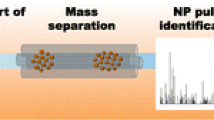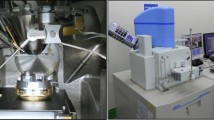Abstract
We introduce an improved particle collection method for uranium isotopic analysis using secondary ion mass spectrometry (SIMS). A new design was applied to a vacuum-suction impactor to promote the dispersibility of collected particles and the air flow rate was adjusted to maximize the particle recovery yield. The improved method remarkably mitigated the ‘mixing effect’. Materials from a nuclear forensic exercise were also employed to evaluate the method applicability. This innovation will be useful to improve the accuracy of SIMS uranium particle analysis, especially for overloaded samples with mixed isotope compositions.





Similar content being viewed by others
References
Donohue DL (1998) Strengthening IAEA safeguards through environmental sampling and analysis. J Alloy Compd 271–273:11–18. https://doi.org/10.1016/S0925-8388(98)00015-2
Donohue DL (2002) Peer reviewed: strengthened nuclear safeguards. Anal Chem 74(1):28A–35A. https://doi.org/10.1021/ac021909y
Ranebo Y, Hedberg PML, Whitehouse MJ, Ingeneri K, Littmann S (2009) Improved isotopic SIMS measurements of uranium particles for nuclear safeguard purposes. J Anal At Spectrom 24(3):277–287. https://doi.org/10.1039/b810474c
Esaka F, Watanabe K, Fukuyama H, Onodera T, Esaka KT, Magara M, Sakurai S, Usuda S (2004) Efficient isotope ratio analysis of uranium particles in swipe samples by total-reflection x-ray fluorescence spectrometry and secondary ion mass spectrometry. J Nucl Sci Technol 41(11):1027–1032. https://doi.org/10.1080/18811248.2004.9726327
Peres P, Hedberg PML, Walton S, Montgomery N, Cliff JB, Rabemananjara F, Schuhmacher M (2013) Nuclear safeguards applications using LG-SIMS with automated screening capabilities. Surf Interface Anal 45(1):561–565. https://doi.org/10.1002/sia.5015
Ruedenauer F, Kuno Y, Donohue D (2001) SIMS particle analysis at the IAEA safeguards analytical laboratory. Proc INMM 42nd Annual Meeting Indian Wells, USA, July 16–19:159
Lewis LA, Knight KB, Matzel JE, Prussin SG, Zimmer MM, Kinman WS, Ryerson FJ, Hutcheon ID (2015) Spatially-resolved analyses of aerodynamic fallout from a uranium-fueled nuclear test. J Environ Radioact 148:183–195. https://doi.org/10.1016/j.jenvrad.2015.04.006
Taylor F, Higginson M, Marsden O, Schwantes J (2020) State of practice and emerging application of analytical techniques of nuclear forensic analysis: highlights from the 5th Collaborative Materials Exercise of the Nuclear Forensics International Technical Working Group (ITWG). J Radioanal Nucl Chem 323(1):415–430. https://doi.org/10.1007/s10967-019-06950-7
Marple VA, Olson BA (2011) Sampling and measurement using inertial, gravitational, centrifugal, and thermal techniques. Aerosol Meas. https://doi.org/10.1002/9781118001684.ch8
Reponen T, Willeke K, Grinshpun S, Nevalainen A (2011) Biological particle sampling. Aerosol Meas. https://doi.org/10.1002/9781118001684.ch24
Acknowledgements
This work was supported by the Research and Operation Program of the Korea Atomic Energy Research Institute (Grant No. 521350) and the Nuclear Safety Research Program through the Korea Foundation of Nuclear Safety (KOFONS) using the financial resource granted by the Nuclear Safety and Security Commission (NSSC) of the Republic of Korea (No. 1405020). The authors would also like to thank Editage (www.editage.co.kr) for the English language review.
Author information
Authors and Affiliations
Contributions
THK contributed to the sample preparation, and data collection. JP contributed to the study design, sample preparation, data collection, and writing the manuscript. NL contributed to the part of data collection and C-GL contributed to the part of study design.
Corresponding author
Additional information
Publisher's Note
Springer Nature remains neutral with regard to jurisdictional claims in published maps and institutional affiliations.
Rights and permissions
About this article
Cite this article
Kim, T.H., Park, J., Lee, NR. et al. Improvement in the particle collection method to mitigate the mixing effect during uranium isotope analysis of environmental samples using secondary ion mass spectrometry. J Radioanal Nucl Chem 326, 1887–1894 (2020). https://doi.org/10.1007/s10967-020-07431-y
Received:
Accepted:
Published:
Issue Date:
DOI: https://doi.org/10.1007/s10967-020-07431-y




